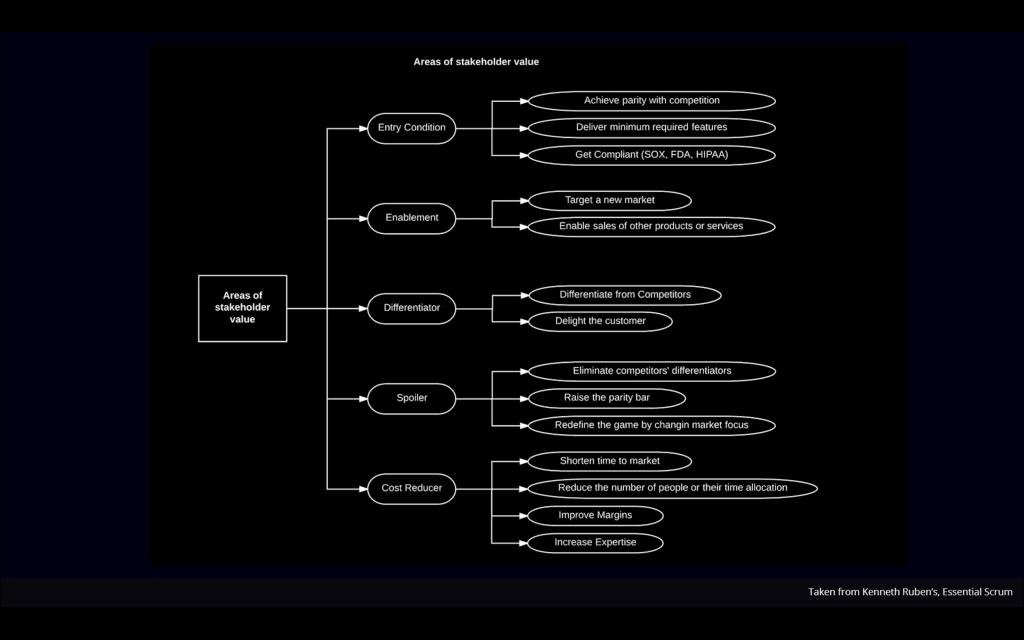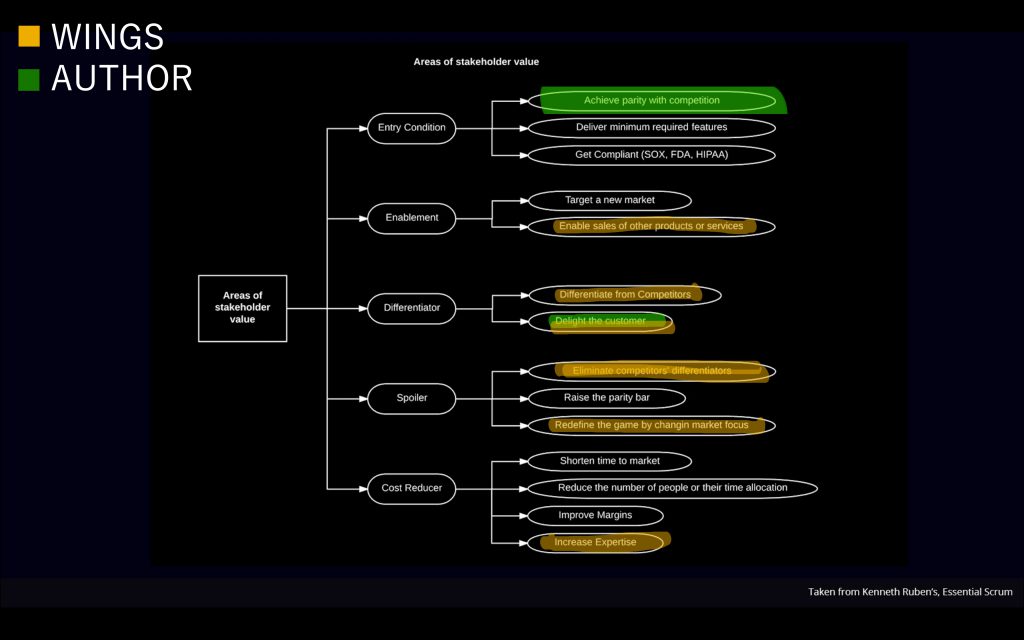The Agile Manifesto:
“We are uncovering better ways of developing
software by doing it and helping others do it.
Through this work we have come to value:
Individuals and interactions over processes and tools
Working software over comprehensive documentation
Customer collaboration over contract negotiation
Responding to change over following a plan
That is, while there is value in the items on
the right, we value the items on the left more” (Beck et al. 2001).
Envisioning (Product planning)
Begin with an idea or concept. A lightweight alternative to charting, ‘envisioning’ should be a fast process. At the start don’t worry about being lofty or vague. In scrum, envisioning happens through the process. All specialisms should be consulted during envisioning. Ruben (2013):
- customers
- features
- high-level solution
- rough costs
Envisioning should include the following activities:
- vision
- target Customer
- key benefits
- purpose of the project
- roles and responsibilities
Areas of stakeholder value
Activity:
I created an activity from The Falmouth University lecture to help me understand stakeholder value. Wings, “invest in indie games with women and marginalized genders developers at key positions” (Wings 2020). Wings have a mission statement, ideology and brand that is about more than just money, and I felt this would make them an interesting stakeholder to pitch to. I highlighted the stakeholders’ values (including myself as a stakeholder).


Creative strategies for defining the vision:
I chose a second activity to complete from the list of creative strategies. I selected Rubin’s (2013) creative strategy ‘the elevator pitch’ and used mind tools guide (Mindtools 2020) to assist with the process.
Mindtools (2020) explains the steps of creating an elevator picth. An elevator pitch, is based on the principle that you only have a few moments to sell or pitch your project (in this case a game) to a stakeholder. As I only have a few moments, it’s important to think quickly. The first is thinking about your goal, which is to create games for everyone. Steps 2 and 3 ask you to think about what you do and your Unique Selling Point (USP) (Mindtools 2020). I am a writer and illustrator with a fasciantion with ancient history, so will try to include this in my elevator pitch. My USP is a difficult point to consider but I am rushed for time. I believe a diverse team, typically overlooked by the indusry will be a USP. After you have thought about the questions (quickly), you put your thoughts together.
My elevator pitch:
My narrative-driven game set in ancient Babylon is for everyone, it is both educational and entertaining with great potential for the mass market. Our diverse team will attract a wider audience and we can breathe the summation of our life experiences.
Scrum estimations for small teams and freelancers
Week 10 focused on the relevance of scrum estimations for small teams and freelancers. You should clarify that estimates are subject to change, focusing on “accuracy but not precision” (Falmouth University 2020). While offering a portrait commission, for example, you should be accurate. An oil painting might take 3 weeks, I would not advise a client that I can paint an oil painting in 360 hours and 33 minutes – I would advise that it would take 3 weeks.
- How many features will be completed?
- When will they be done?
- How much will it cost?
(Falmouth University 2020).
Estimation and The Bucket System
There are several Agile methodologies for estimation of complex projects and numbers in a team .”The “Bucket System” is a way to do an estimation of large numbers of items with a small to a medium-sized group of people, and to do it quickly” (Berteig 2013). A physical diagram is set on the tables of numbers from 0 to 5 then 8, 13, 20, 30, 50, 100 and then 250. Tasks are written on cards and the first card picked at random is placed at number 8 for reference. The team discuss the first few tasks on the cards and then everyone is given their own tasks to place on the scale of estimation (Berteig 2013).
I researched alternatives to The Bucket System and found Planning Poker, which to begin with sounds like more fun to me. Planning Poker is another estimation activity used in Agile practice. Planning Poker “Planning Poker helps team members by reducing the stress of individual accountability and instead focussing on team accountability” (Berteig 2020).
There are many activities to estimate with everyone involved in the success of the project.
Challenge Activity
Approaches to time management
“Be it a university assignment or a work-related task you found challenging to complete, what tactics and approaches did you employ to complete them successfully” (Falmouth University 2020)?
“Given what you’ve learned about Agile and time management in this course thus far, do you think you could adapt your tactics to Agile methodologies” (Falmouth University 2020)?
While working on my final project for my BA in Classics and Creative Writing at The Open University, I was also moving home unexpectedly. My entire study at The Open University meant working around significant responsibilities. But there are many determined and exceptional students at The Open University reaching their goals against the odds.
I employed the following tactics:
- I developed robust self-discipline for study. I am a reformed procrastinator, every moment I have spare I used to study. The pace I worked at for my final project wasn’t maintainable for long periods of time. At one stage, I did nothing but work, take care of my son or study. But to push through the last few months, it was something I had to do.
- Never leave the house without some study materials. While waiting for your doctor’s appointment, the bus, or your friend to show up to go shopping – have something to read. I always have some task that I can complete to hand, a sketch, reading material, a notebook to make notes and record thoughts.
- Lists, lists, and lists! To-do lists, weekly schedules and spreadsheets to keep track of your time and your progress.
- Taking a break. I used the Pomodoro technique to ensure I took a short rest every twenty minutes. If you don’t rest, your work will start to turn to gibberish.
- Leaving the work I enjoy the most for the last thing I do in the day.
Agile Practice is designed for teams, but the Agile manifesto is still relevant in many ways. While working on my own, I adopted my approach:
“Responding to change over following a plan” (Beck et al. 2001).
“Responding to change over following a plan” (Beck et al. 2001) is something I have adapted since studying my BA (Hons) and on occasion while working as an assessor for The Open University. The Vocational Qualification Assessment Centre employed all their assessors as freelancers. I worked as an assistant to the centre and an assessor in Business and Administration and Customer Service. Learners were required to complete a combination of observation, written and oral work to pass their qualifications. While assessing learners at their place of work, it was rare anything ever went to plan. In preparation for an observation visit, I would formulate a plan for my learner to meet the assessment criteria, but I would also need to think on my feet. Sometimes I would interview my learners to demonstrate their understanding of criteria that might have been missed, or I’d ask them to show me email communications from a previous date that proved they understand how to resolve a complaint. So I have always adapted to responding to change.
“Working software over comprehensive documentation” (Beck et al. 2001).
“Working software over comprehensive documentation” (Beck et al. 2001) was again a priority at The Open University’s Vocational Qualification Assessment Centre. My responsibilities included maintaining the customer-facing website and learner resources website. If I had prioritised documentation first, learners would ring up and complain in a heartbeat that they don’t have access to the materials they need.
Adapting Agile Practice to my studies
I want to research beta testing games, early access and how Agile methodologies play a part in these games development cycles. The cycles of sprints, rapid ideation and feedback throughout Development Practice has been an effective way to improve my skills. I have surprised myself with how much I have learnt.
Agile methodologies and reflective practice are two things I would like to continue to practice. For Rapid Ideation 1 and 2, and our side project Game Off 2020, I adapted my tactics to Agile methodologies as part of a team or my own. I have begun to think about Agile Practice and adapt it to my studies, teamwork, and continuing development.
Reflection and feedback are core elements of being ‘agile’. I have found that I have gotten to know myself better over the last ten weeks. “With each sprint, we can reflect on the performance and outputs of that batch of work. By combining the learning, action and reflection from previous sprints of activity, we can review and measure against our goals, objectives and chosen direction to ensure we are doing the right thing and the thing right” (Waldock 2015: 118). The process of reflection has not always been easy. Looking at my goals, my output from sprints of activity and reflecting on my actions forced me to see where I went wrong. At times I have struggled to be honest with myself but pushing through those barriers I have adapted as a person.
The Agile approach supports reflection. “In order to reflect well, we must take time to gather a clear picture of the reality of our actions” (Waldock 2015: 118). “Regular reflection is interwoven into the fabric of agile methodology” (Waldock 2015: 118). Agile methodology has been woven into this Development Practice module. Envisioning, Sprints, Retrospectives and Feedback (Waldock 2015) all support our reflection. Regular reflection can tell us “what is going well and what we can improve upon (Waldock 2015: 124). Now that I have begun this process of reflecting on my output, it’s become habitual, and I don’t think I can stop.
List of figures
Figure 1. Areas of Stakeholder value [screenshot by author].
Figure 2. Highlighted screenshot [screenshot by author].
References
BECK, K et al. 2001. ‘Manifesto for Agile Software Development’. [online]. Available at: https://agilemanifesto.org/ [accessed 24 November 2020].
BERTEIG, Mishkin. 2013. ‘Agile Estimation with the Bucket System’. Agile Advice [online]. Available at: http://www.agileadvice.com/2013/07/30/referenceinformation/agile-estimation-with-the-bucket-system/ [accessed 24 November 2020].
BERTEIG, Mishkin. 2020. ‘The Planning Game – An Estimation Method for Agile Teams’. Berteig [online]. Available at: https://berteig.com/how-to-apply-agile/the-planning-game-an-estimation-method-for-agile-teams-2/ [accessed 24 November 2020].
Falmouth University. 2020. ‘Week 10: Spark Forum’. Falmouth Flex [online]. Available at: https://flex.falmouth.ac.uk/courses/872/discussion_topics/18810 [accessed 24 November 2020].
Mindtools. 2020. ‘Crafting an Elevator Pitch: Introducing Your Company Quickly and Compellingly’. [online]. Available at: http://www.mindtools.com/pages/article/elevator-pitch.htm [accessed 24 November 2020].
RUBIN, Kenneth S. 2012. Essential Scrum: A Practical Guide to the Most Popular Agile Process. Upper Saddle River, NJ: Addison-Wesley.
WALDOCK, Belinda. 2015. Being Agile in Business: Discover Faster, Smarter, Leaner Ways to Succeed at Work. Harlow, United Kingdom: Pearson.
WINGS. Available at: https://wingsfund.me/ [accessed 24 November 2020].
WINGS. 2020. ‘WINGS: Our Mission’. Medium [online]. Available at: https://medium.com/wings-blog/wings-our-mission-2b3b2c5faf24 [accessed 24 November 2020].